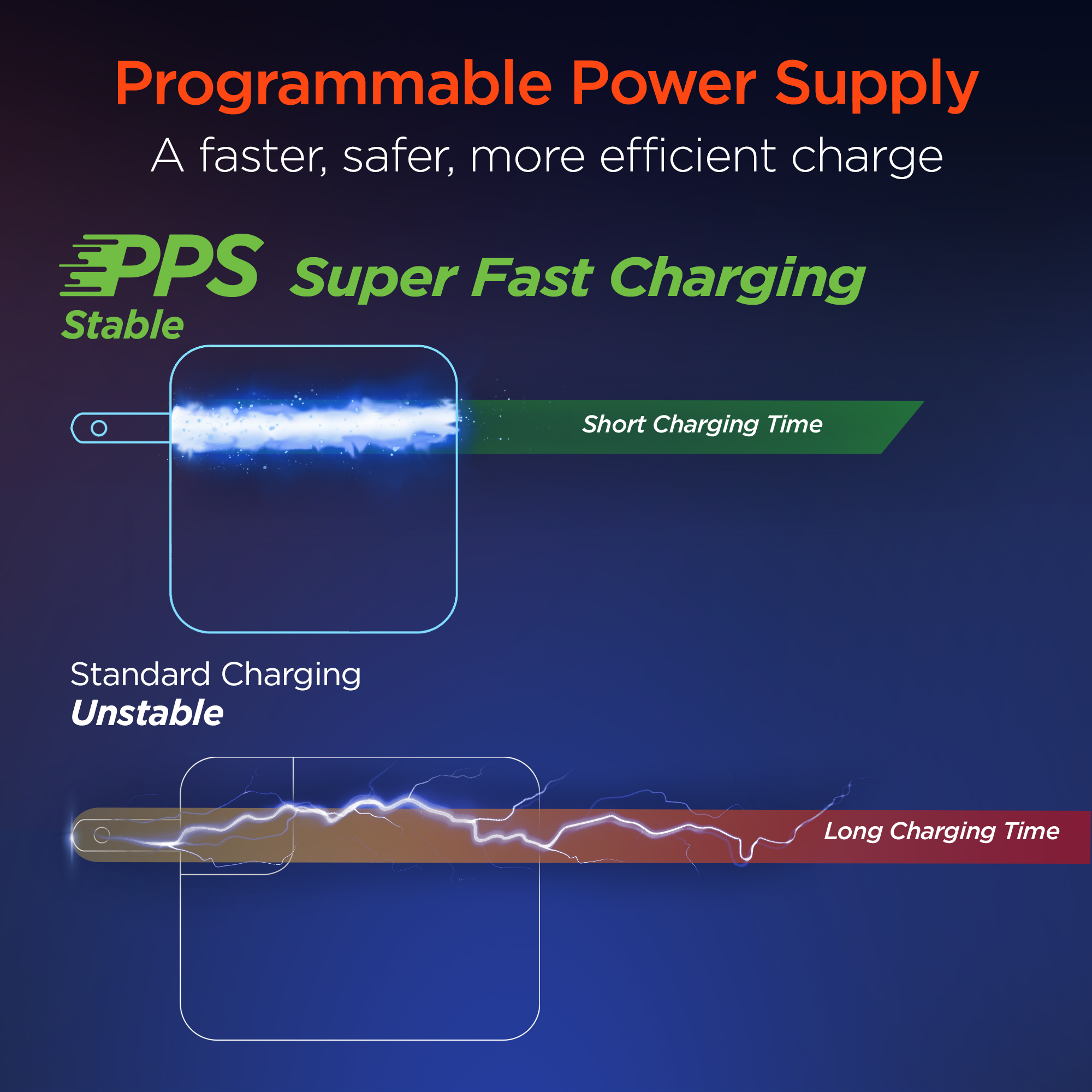PPS
USB-C Power Delivery (PD) technology enables very fast charging speeds by sending high-voltage/low-amperage power from a charger to a phone – and then the phone’s internal charging system unpacks the delivery, converting that power it into the low-V/high-A form that its rechargeable batteries require.
The conversion process is fast, but there’s a catch: the process cannot be perfectly efficient. Some of the energy escapes as heat, which is then trapped inside the phone, right on top of the battery. These “conversion losses” damage the battery and weaken it over time, reducing its maximum capacity and eventually ruining its ability to hold a charge.
But, by enhancing the PD chipset inside the charger with Programmable Power Supply circuitry, a PD/PPS charger can handle all of the heat-generating power regulation processes within itself so the phone doesn’t have to – no conversion required. The phone can fast charge without getting hot, which means it can charge even faster.
SMALL CHANGES – BIG DIFFERENCE
Regular PD chargers are configured to output power at several fixed voltage levels. The list is standardized, which is what allows PD chargers to be universally compatible. As soon as a phone is plugged in, it selects the voltage level that its internal power regulation system is designed to convert, and the PD charger’s only job is to keep delivering power consistently. The phone handles all the voltage conversion and amperage optimization inside of itself – generating a lot of heat.
With PPS circuitry added, a PD/PPS charger can also operate within a flexible voltage range. Phones can select customized power output levels, which eliminates the need for the heat-generating conversion process. The PD/PPS charger connects directly to the phone’s battery system, where the high-voltage power is divided exactly in half. It’s a simpler process, so it’s extremely efficient and much cooler – and this is how phones make the jump from 20W fast charging to 25W super-fast charging.
WHAT PD/PPS SUPER-FAST CHARGING LOOKS LIKE
Lithium battery charging cycles follow a two-phase pattern, and both phases require frequent micro-adjustments for optimization and safety – especially as they get faster and more powerful. Since the PD/PPS charger is connected directly to the phone’s battery, the phone must be able to control the charger as if it were its own internal power regulation system.
The PD/PPS charger’s customized output can be adjusted in fine detail at the phone’s request – as often as every 10 seconds. These “stepwise” changes allow for real-time optimization every single time the phone super-fast charges.
Phase 1: Constant Current
While the battery’s internal voltage is low, it can absorb high-amperage current – the more stable the current, the more battery capacity filled before its voltage gets too high. The PD/PPS charging voltage can be adjusted in 0.02V steps to keep the current constant.
Phase 2: Constant Voltage
As the battery’s voltage approaches its upper limit, the current must be ramped down to prevent overvoltage. The PD/PPS charger can lower the current in steps as small as 0.05A at a time – a gentle curve allows the battery to finish charging as fast as safely possible.
THE FUTURE OF FAST CHARGING
Fast charging devices that depend on internal voltage conversion will always have to deal with conversion losses threatening to overheat their batteries. Phones are too small to fit the fans and liquid cooling systems that computers use, so phones are instead built with thermal management components and heat-dissipating materials, and their software is programmed to minimize hot processing.
These methods work well, but the technology has reached a plateau. Internal-conversion charging cannot safely get faster than it currently is – faster charging would require higher outputs, which would mean more power to convert, which would create unmanageable amounts of heat.
But now, with Programmable Power Supply chargers that are capable of handling power regulation externally, protecting the battery from heat has become much less of a concern. Fast charging speeds will continue to improve, and the space that has to be reserved for thermal management components can be freed up for things like better cameras, more powerful graphics processors, and larger, longer-lasting batteries.


